We arrived at Hong Kong International Airport early Monday morning. Even from middle-of-nowhere Sham Tseng, it only took one transfer and 30 minutes - the 308M green minibus to Tsing Yi, and the Airport Express one stop to the airport. Remember those stats.
Check-in, baggage drop-off, security and customs all went through quickly and efficiently, like all things in this city, leaving us with some extra time in the airport. We stopped by the McDonald's - apparently my brother wanted a hash brown, and I spotted something on the local breakfast menu.
It was a Filet-o-Fish. At 8:00 in the morning. And I just had to have it. Apparently they really like fried fish for breakfast here - it's on the menus of Café de Coral, Fairwood, and Maxim's MX too. At 9:30 we were at the gate for our 10:00 flight on a Cathay Pacific A330.
The plane ride was incredibly short, and the amount of service that we got in that short time made it feel even shorter - a full meal consisting of a hot ham and egg sandwich, fresh watermelon, and apple juice. An hour and a half later, we were in Taoyuan International Airport (桃園國際機場).
Customs was incredibly easy - a Canadian passport is really helpful in most parts of the world - and our baggage came out onto the carousel just as we arrived.
And then we had to get to the hotel. A shuttle bus to the nearby high-speed rail station took about 15 minutes.
The train ride took another 20.
Then we transferred to the subway (officially the Taipei Metro, also known as the MRT and in Chinese 台北捷運) for another 15 minute ride.
 |
| The tip of Taipei 101 from one of the stations. |
Finally, we had to walk to the hotel, located along a subway line but some 600m away from the nearest station (for comparison, the stations along Danforth Road in Toronto are about 300-500m apart from each other).
 |
| There are so many motorcycles and Vespas parked, there's barely a sidewalk! |
...and this is within the city centre of Taipei.
The hotel itself, though, was (is?) incredibly nice. Hotel B (台北碧瑤飯店), located in Songshan,Taipei City, a few kilometres south of the domestic Songshan Airport (松山機場), and a few blocks northwest of Taipei 101 (台北101), is a small, unassuming highrise in a sea of similar buildings. The only criteria I had for choosing a hotel was that it would be relatively cheap, relatively close to a subway station, and also could accommodate four people (many in this crowded city can only do two, or at most three). This hotel, on first glance, met all three, and had mostly positive reviews. But I did not expect the accommodations that I got. It's small by North American standards, but comfortably fits two queen beds and this work alcove I am currently typing in, as well as a pretty decently sized bathroom. The décor is more in line with a Grand Hyatt than something in this price range. The pillows are down (or feather),and the bedding is comfortable. Upon arrival, we were greeted with four bottles of spring water and a selection of local tea and coffee. Really, the only bad things about this hotel were the distance from the MRT and the slow Wi-Fi preventing me from uploading photos!
Sun Yat-Sen (孫中山, pinyin Sun Zhongshan) was responsible for the end of Imperial China, creating the Republic of China (中華民國) in 1912, and putting into power his party the Kuomintang (KMT, 國民黨).
After the Chinese Civil War ended (officially it's still going on!) in 1949 with the declaration by Mao Zedong in Beijing of the People's Republic of China (中華人民共和國), the KMT retreated to their last outpost in Taiwan, where they remain today. Sun Yat-Sen remains unique among Chinese politicians in that he is called by both Taiwan and mainland China the "father of the country", for ending Imperial rule. This Hall has various exhibits showcasing local artistic talent, a permanent exhibition chronicling the life of Sun Yat-Sen, and a giant Lincoln-esque statue of him in the front hall.
 |
| They still count years here from the fall of the Qing Dynasty, 1911. 2012 is the 101st year. |
We then walked over to the Taipei City Hall, where the Discovery Centre of Taipei, an exhibition of local history, was located. That building is extremely confusing, as it serves as the main municipal services building for the city - meaning we could find signs to everything a resident could need, but none to the Centre. When we finally found it, "Closed on Mondays" was what we saw at the entrance. So much for that idea.
Over to Taipei 101 then.
We wandered the mall at the base for a bit and bought some pineapple cakes (鳳梨酥), a small rectangular glob of pineapple and sugar surrounded by a soft, shortcake crust considered the signature pastry of the island, for afternoon tea.
Queuing to buy tickets for the observatory, we learn that due to the rain, the outdoor lookouts were closed. So much for that idea too.
Finally, we headed to the Eslite Bookstore (誠品書店), a large 24-hour bookstore that has become something of a local institution, with a mini-mall and food court in its basement. One of my uncles wanted some book...
And for dinner, we went to a Din Tai Fung - a local company, so I expected the food here to be somewhat better. And it was. (It has recently come to my attention that the one that I went to in Tsim Sha Tsui had one Michelin Star. I couldn't believe my eyes.)
Tuesday, August 7.
Waking up at 8, we went downstairs for the complementary breakfast. Wow. It had a pretty nice selection of Taiwanese items - congee with your choice of local pickles, pork floss (individual strands of pork protein coaxed out by stewing the meat in a soy sauce mixture to remove the collagen and elastin)... fried rice, veggies, tofu, some meat items, eggs, mantou...
...but the only western thing there was toast. Meh.
We headed out to the Taipei Zoo, the largest in Asia.
The Zoo houses a large number of species unique to the island:
 |
| It's an Ursaring! |
an even larger number of well-known species from around the world:
and is the home of two more pandas. These ones, however, have a story behind them. In 2005, Beijing announced it would send two pandas over to Taiwan as a show of goodwill between the two (technically warring) sides. However, the then-President, Chen Shui-bian, leader of the pro-independence Democratic Progressive Party (DPP), blocked their arrival, seeing it as a threat to the de facto Taiwanese independence from Beijing. After Ma Ying-jeou, of the KMT, won the Presidential election in 2008, he began to forge greater economic (and by extension political) ties with Beijing, and the pandas were sent over. Their names, Tuan Tuan (團團) and Yuan Yuan (圓圓), combine to form the word tuanyuan (團圓), meaning "reunion", a move still strongly resented by the DPP and Taiwanese Independence supporters generally.
The zoo is located in the Muzha region, a mountainous area in the south of Taipei. Another popular attraction there is the Maokong Gondola (貓空纜車), a cable car which travels between the zoo and the tea plantations in the mountains.
Getting on at the back of the zoo instead of the front, we had to wait a while for a cabin to come along.
The ride was quite nice, having some great views over the entire city - we started out seeing only the top of Taipei 101 in the background behind the mountains, and as we worked our way up the mountains (swaying over huge valleys - scary!), the whole of Taipei unfolded beneath us.
...which wasn't really that stinky. Disappointing.
Maokong is Chinese for "cat's empty/hollows", apparently referring to the numerous valleys that dot the area.
It has historically been an important place for growing tea in Taiwan, particularly of one variety - tieguanyin (鐵觀音, lit. iron Guanyin), a variety of oolong (a classification of semi-fermented (oxidized, not actually left to ferment) teas between green [non-fermented] and black [completely fermented]). This tea has a very strong floral and fruity aroma, and has a sour-sweet taste with a somewhat astringent mouthfeel and a fruity finish. It is one of the most popular varieties of oolong, and the finest cultivars can be among the most expensive teas on the market. It's also my brother's favourite.
We stopped by a local restaurant, and had a completely random meal where we had fries, onion rings, chicken nuggets,
stir-fried veggies in tea oil,
and red-braised tofu (紅燒豆腐) with rice.
Oh, and my brother had waffles with whip and fruit for lunch.
To top that completely random assortment of foods, we ordered a set of tieguanyin. How this works is that you pay firstly for the tea, and then pay separately for the utensils used to prepare and drink it - what they call a water fee (水費). The waiter patiently took us through the steps in preparing the tea, and told us exactly how to make it to get the most benefit - how long to steep it initially, how long the subsequent infusions should take, when to replace the tea leaves, etc. The tea was great.
Of course, drinking all that liquid...
This sign should be familiar to you guys:
but maybe not this one.
In Taiwan, toilet stalls are usually marked with one of these two symbols, to indicate the type of toilet facility in each one. The first kind is of course, a seated toilet, where the user sits and evacuates. The second kind, practically unknown in the West, is called a "Turkish", "Japanese", "Oriental", or a myriad of other foreign sounding names. It is basically a hole in the ground with a flush function. Users squat over it and evacuate. Proponents of this toilet claim that it is more sanitary (no splashback, less places that a user touches) for a public toilet, and that the human body's natural evacuation position is that of a squat.
Confuses the heck out of Westerners though. And the funny (and sometimes true!) anecdote that is usually repeated in Hong Kong is that when mainland visitors arrive and find only seated toilets, they have to resort to squatting on top of the seat, as they have only ever used squat toilets, considered cleaner in places with lower sanitation than ideal, such as most parts of rural China.
But enough potty talk. Back to the topic at hand.
Confuses the heck out of Westerners though. And the funny (and sometimes true!) anecdote that is usually repeated in Hong Kong is that when mainland visitors arrive and find only seated toilets, they have to resort to squatting on top of the seat, as they have only ever used squat toilets, considered cleaner in places with lower sanitation than ideal, such as most parts of rural China.
But enough potty talk. Back to the topic at hand.
We walked around the mountain to the Tea Promotion Centre, where there are some tea fields and an exhibit on the making of tieguanyin (Wiki has a good flowchart of the complexities involved). Unfortunately, for some reason, the fields were closed, and so after a quick look around the exhibit room, we had nothing to do but leave.
On the way back, we passed several tea shops, and eventually stopped in one, where we first sampled and then purchased a selection of tieguanyin and baozhong (包種, lit. "wrapped kind") teas. Baozhong is another oolong variety that is grown in these parts that has a much lighter colour and softer aroma and taste.
 |
| Yep, several tea shops in the area. |
On the ride back, we chose to take the glass-floored version of the cable car.
 |
| Dangling over the tea fields below. |
Back in Taipei, we went to the Longshan Temple (龍山寺). As with many Chinese temples, it is both a taoist and buddhist temple, with many traditional Chinese deities but also the bodhisattva Guanyin being venerated here.
Then we hopped over to Ximending (西門町, lit. west gate "ding", or Japanese for "district"). The concept of calling districts "ding" came from the Japanese colonial period, and remains today, as do many Japanese legacies.
A landmark in the city is the Red House (西門紅樓), a market built in 1908 by the Japanese colonials, originally selling Japanese goods for those officials missing the luxuries of home. It was converted into a theatre in 1945, and is currently an artist's market.
Ximending is a popular shopping distict in the city, with street food stalls opening up later in the night.
We stopped by a place that specialized in the Japanese deep-fried dishes (most notably tonkatsu, a deep-fried pork cutlet) for dinner. We were all full afterward, and we paid in total NT$695, just over $23 CAD.
As we were leaving, the food stalls were just opening up, but oh well. There would be plenty of time for that on later nights.
We hopped back on the MRT and headed to the hotel.


























































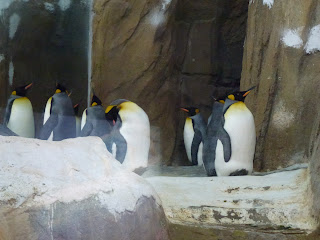

























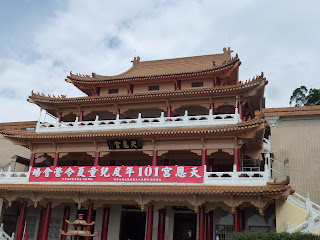




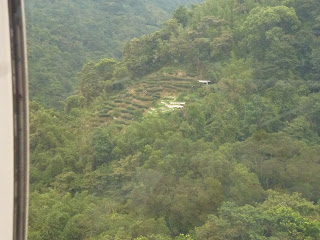



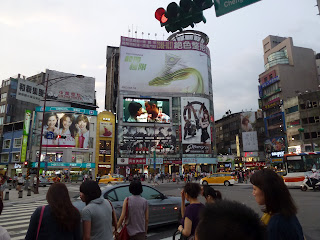



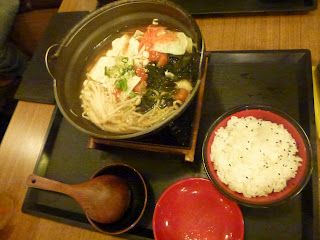




No comments:
Post a Comment